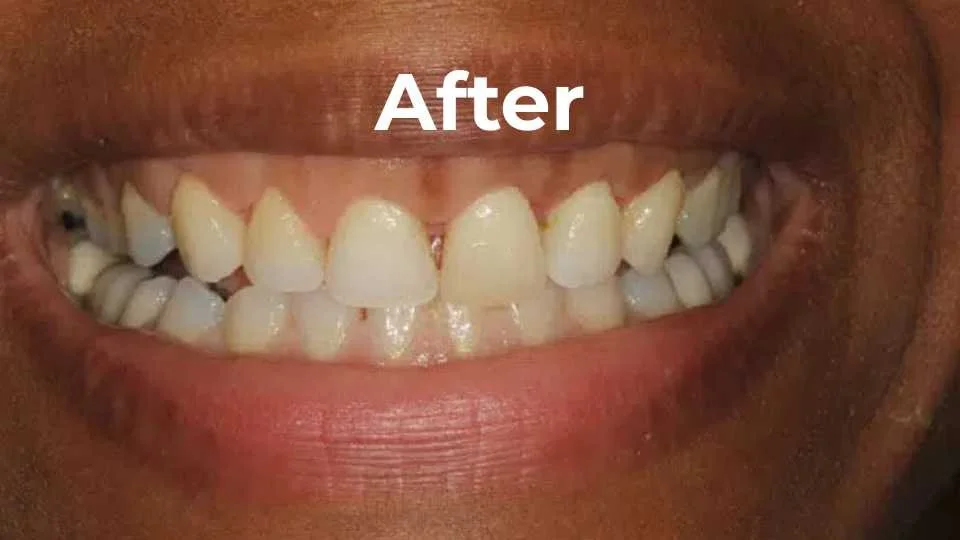Gummy Smile Correction in Midtown NYC
What Is a Gummy Smile?
A gummy smile, also known in dental terms as excessive gingival display, is when the gums are showing too much making the teeth appear small. About 10-20% of people are estimated to have gummy smiles or feel self-conscious that they show too much gum tissue. Gums frame the smile much like a frame enhances a picture. When the gums are not in the correct proportion relative to the teeth, the smile does not look nice.
Typically, the ideal smile shows about 2-3mm of gum from the bottom of your lip to the top of your teeth, with women typically showing a little more gums than men. When more than this amount of gum shows, the teeth can appear smaller or the gums can look very large giving someone a gummy smile.
Dr. Scott Froum provides gummy smile correction to patients in Midtown NYC, helping to create more balanced, natural-looking smiles by reshaping excess gum tissueIf you are unhappy with how much your gums show when you smile, contact us at 212-751-8530 to schedule an appointment.
What Does a Gummy Smile Look Like?
Gummy smile caused by gum overgrowth after braces making the teeth look small. This was corrected by reshaping the gum tissue to reveal more of the teeth.
Gummy smile correction with a dental laser, removing excess gum tissue and reshaping them around the teeth giving them the correct proportion enhancing the esthetics of the smile.
What Causes a Gummy Smile?
Jaw Growth
As you age and develop, your jawbone grows downward and outward, with the teeth and gums adapting along with it. The teeth naturally grow down and the gums naturally grow upward. In some cases, the gums do not grow in the right direction or at the right speed relative to the teeth. This process, known as delayed passive eruption in dental terms, can result in a gummy smile. In other instances, your upper jaw can be out of position making the upper jaw look a lot longer than it should and causing excess gum display when smiling.
Inflamed Gums
Bacteria in the gums can cause them to become inflamed and swollen. Gums that look puffy or enlarged due to gingivitis or gum disease can create the appearance of a gummy smile. In some cases of advanced gum disease, the gums tissue can overgrow the teeth, further contributing to excess gum display. Common causes of gum disease and inflamed gums include, poor oral hygiene, not getting regular professional cleanings, orthodontics applications ( such as braces, which can be a food trap), pregnancy-related hormonal changes , and certain medical diseases.
Hypermobility of the Lip
The muscles of the face, known as elevator muscles, are responsible for movement of your upper lip when you smile. In some people, these muscles pull the upper lip upward more than normal, causing it to elevate the lip higher than normal. When your upper lip is hypermobile, you will show more gums than average, even if your gum tissue and tooth proportions are normal.
Genetics
Some people have naturally small teeth crowns, which can make gums look bigger, while others simply have more gum display when they smile. Much of this can be genetically determined.
Treatments to Fix a Gummy Smile
There are several treatment options available for fixing a gummy smile, including a laser gum tissue removal, upper lip repositioning, jaw surgery & braces, and Botox injections. The most appropriate treatment will depend on why you have a gummy smile in the first place.
Treatment options for a gummy smile include:
-
This procedure uses a laser to gently remove excess gum tissue and reshape the way your teeth look for a more balanced smile. This procedure is quick, minimally invasive and provides immediate results. Full healing can usually take 6-12 weeks.
-
When teeth are misaligned or have not developed enough, orthodontic treatment can move the teeth into a more ideal position, which may naturally cause the gumline to recede as it would during normal development.
-
This is a more intensive procedure that repositions your upper jaw to correct an overgrowth or misalignment that causes excess gum display. This procedure is done in a hospital setting by an oral and maxillofacial surgeon and may be recommended in severe cases.
-
This procedure is used to treat a hypermobile upper lip and it ties the inside of the upper lip to the gums restricting the movement of the upper lip. Because this tying is done on the inside of the upper lip,there are no visible scars or changes to outward appearance.
-
This treatment uses a neurotoxin known as botulinum toxin A, or Botox, to temporarily relax the muscles that elevate the upper lip.The gums will appear smaller because the upper lip will mask the amount of gum tissue you have. The effects of Botox typically last 3-6 months and require maintenance treatments once the effects of the neurotoxin wear off.
A gummy smile can affect your confidence and desire to smile. Because there are so many effective treatments available to correct this problem, contact your periodontist today to uncover why you have a gummy smile and explore the best treatment options for you.
Frequently Asked Questions
-
If you feel your gums show more than you'd like when you smile or you're self-conscious about how your teeth appear, you may benefit from a consultation. Dr. Scott Froum can evaluate the proportions of your teeth, gums, and jaw to determine if treatment would enhance your smile's balance and esthetics.
-
Gummy smile correction options vary depending on the cause. Treatments may include laser gum contouring, crown lengthening, lip repositioning surgery, Botox injections to reduce upper lip movement, orthodontics, or jaw surgery in more advanced cases. Dr. Froum customizes your treatment plan based on your unique anatomy and goals.
-
Many gummy smile treatments are minimally invasive and involve little to no discomfort. Laser procedures and Botox injections, for example, typically require only local anesthesia and have minimal downtime. Dr. Froum uses advanced techniques to ensure your comfort throughout the process.
-
Recovery time depends on the specific treatment. Laser gum contouring generally heals within 1 to 2 weeks, while lip repositioning may take a little longer. Jaw surgery involves a more extended recovery period and is reserved for severe cases. Dr. Froum will walk you through a personalized recovery plan.
-
Insurance coverage depends on whether the procedure is considered medically necessary or cosmetic. Functional treatments (such as crown lengthening for restorative work) are more likely to be covered than purely cosmetic procedures. Our office team will assist you in verifying your benefits before treatment begins.
-
Yes, in some cases. Braces and orthodontic appliances can sometimes lead to gum overgrowth, particularly when oral hygiene is more difficult to maintain. This excess tissue can cover part of the teeth and create a “gummy” appearance, which may require contouring or laser treatment after orthodontic care is complete.
-
Attractiveness is subjective, and many people with gummy smiles have beautiful, confident smiles. However, if excess gum tissue causes you to feel self-conscious, there are cosmetic procedures that can adjust the gum-to-tooth ratio and create a more balanced appearance.
-
Gummy smiles can be caused by several factors, including genetics, jaw development, a hyperactive upper lip, small or short teeth, excessive gum tissue, or orthodontic influences like braces. In some cases, gum inflammation from poor oral hygiene or medical conditions can also play a role.
-
Braces may help in certain cases, especially when tooth position or jaw alignment is contributing to the gummy appearance. However, if excess gum tissue or a hypermobile upper lip is the cause, other treatments—like laser contouring, crown lengthening, or lip repositioning—may be needed.
-
In some cases, yes. As a child’s face and jaw continue to develop, the proportions of the teeth and gums can improve naturally. However, if a gummy smile persists into adolescence or adulthood, an evaluation by a dental specialist can help determine if treatment is needed.
-
A gummy smile can develop for a variety of reasons, including developmental problems, poor oral hygiene, orthodontic issues, skeletal issues, genetics, and gum disease.
Contact Us
Ready to fix your gummy smile? Contact our office today to schedule your gummy smile consultation with Dr. Scott Froum.




